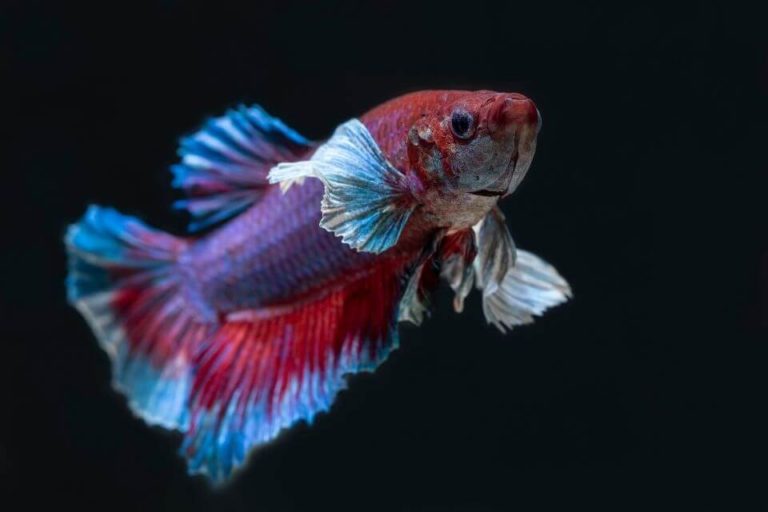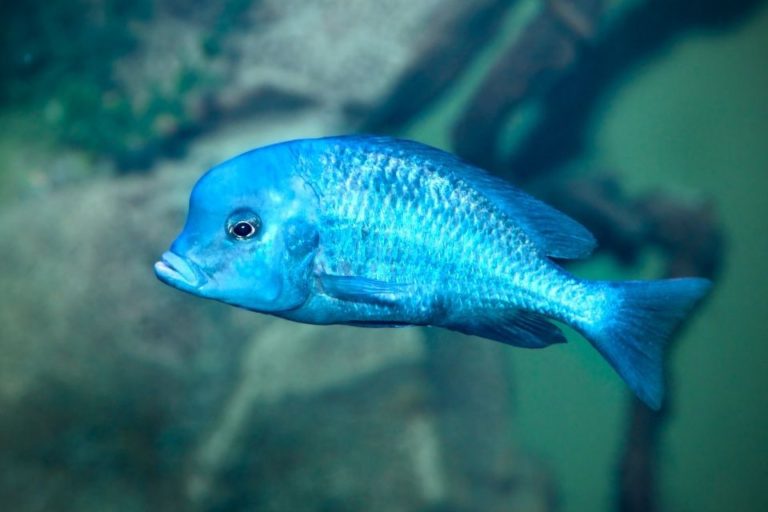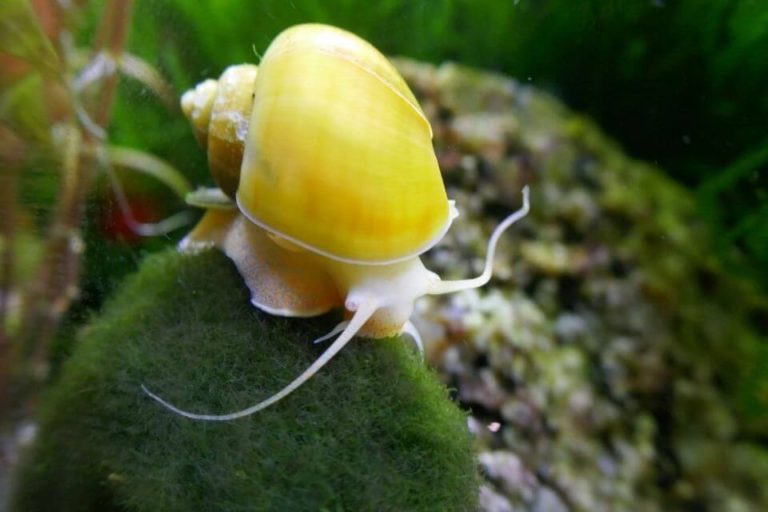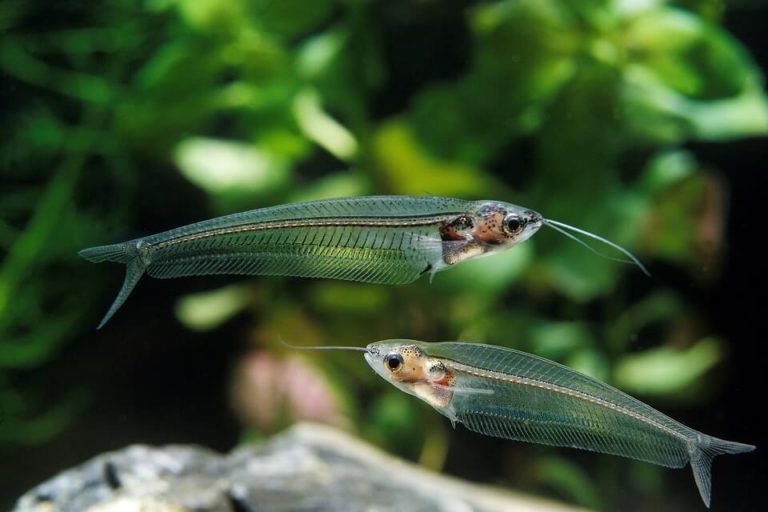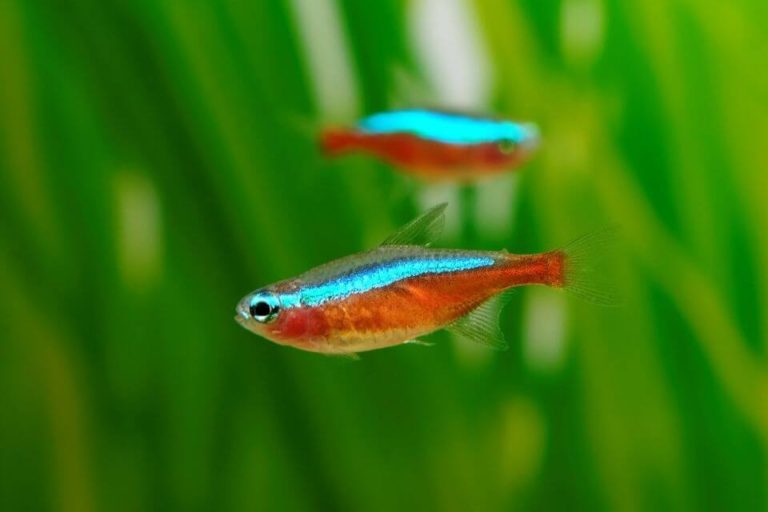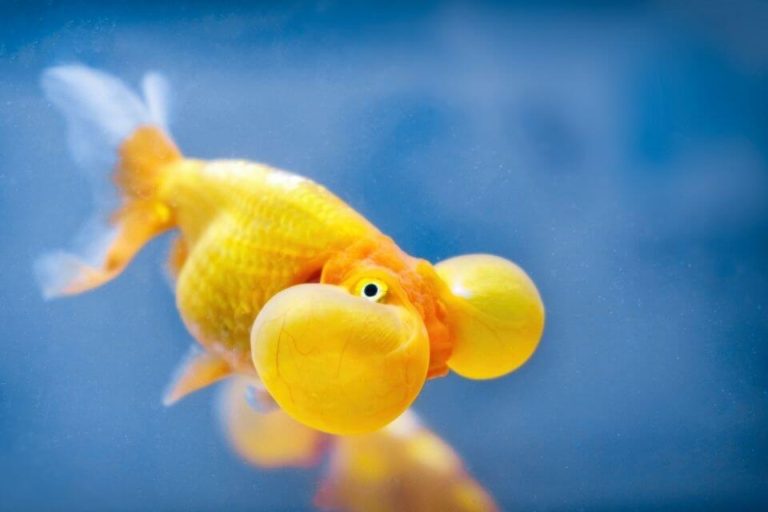Galaxy Rasbora Care (Celestial Pearl Danio): Size, Lifespan & Tank Mates
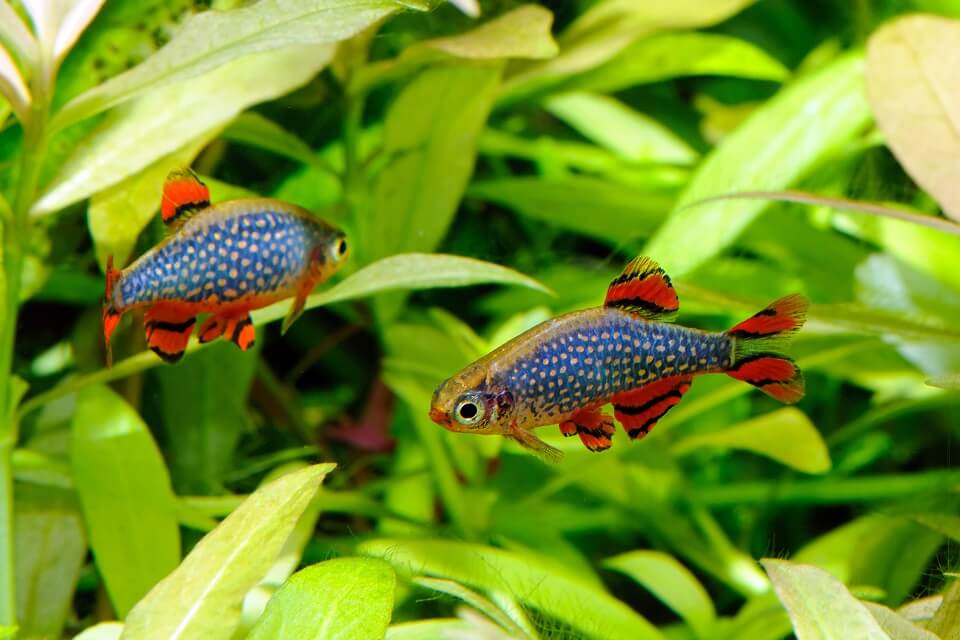
Rare and recently discovered, the Galaxy Rasbora or the Celestial Pearl Danio is a colorful little fish that can make a good addition to your freshwater tank.
If you are considering adding more small fish to your aquarium, you might enjoy the unique colors and patterns offered by this Danio species.
Interestingly enough, the Galaxy Rasbora was only discovered in 2006 in the eastern river basins of Inle Lake in Hopong (A village of Myanmar).
Since these tiny treasures only exist in a handful of small ponds and rivers across Southeast Asia, they have quickly become one of the most desired fish of beginner and expert Aquarists alike.
Below, you will find a thorough care guide for these exciting fish. Taking care of Galaxy Rasbora is not too difficult and you might find these peaceful fish a perfect addition to your freshwater aquarium.
| Quick Facts: | |
|---|---|
| Common Names | : Galaxy Rasbora, Celestial Pearl Danio |
| Scientific Name | : Danio Margaritatus |
| Family | : Cyprinidae |
| Origin | : Inle Lake in Hopong (A village of Myanmar) |
| Care Level | : Easy |
| Lifespan | : 3 to 5 years |
| Size (average) | : Up to 1 in (2.5 cm) long |
| Diet | : Omnivore eater |
| Breeding | : Egglayer |
| Social | : Schooling fish |
| Temperament | : Peaceful |
| Minimum Tank Size | : 10 Gallons |
| Temperature | : 73°F – 79°F (22°C – 26°C) |
| Water Hardness | : 2 - 10 dKH |
| Water pH Level | : 6.5 - 7.5 |
Galaxy Rasbora Overview
Fish keepers across the globe were shaken up by the discovery of the Galaxy Rasbora in the early 2000s. Aquarists of all experience levels lined up at fish stores to get their hands on these colorful new fish.
This species is known for its incredible color and pattern combinations, which can make a lively addition to any kind of aquarium.
These species are scientifically named Danio Margaritatus, while it is called Galaxy Rasbora and Celestial Pearl Danio in the aquarium industry.
The Celestial Pearl Danio is a small freshwater fish that lives in areas with high vegetation. They prefer to stay in calm waters with lots of light and an open environment around them.
They may be a bit timid when you first introduce them to your tank, so having places for them to hide is very important.
Galaxy Rasbora Size
These fish are some of the smallest freshwater fish species available for freshwater aquariums. They can be just a few millimeters long when born, and Celestial Pearl Danio size up to about 1 inch (2.5 cm) in size when it is fully grown.
Most Celestial Pearl Danios do not grow more than 1 inch.
Galaxy Rasbora Lifespan
Celestial Pearl Danios do not live very long. On average, they have a lifespan of 3 to 5 years. Living in large groups can increase their survivability, and you can also breed them to encourage a continuation of the school.
Galaxy Rasboras can remain in good health for several years before they start to show signs of aging.
Typical Galaxy Rasbora Behavior
Celestial Pearl Danios are somewhat timid. Because of their small size, they are shy when it comes to interacting with other fish. While peaceful, they may need to hide behind aquarium rocks or in aquarium plants for a while.
They do tend to get along with most freshwater fish around their size, however. It is highly recommended to keep Celestial Pearl Danio together as a school in order for them to feel more secure and protected.
This will also allow them to display their lively behaviors as they swim around the bottom of the tank looking for something to eat. Most Aquarists prefer to keep them around other fish that display similar behaviors.
The size and habitat of your tank play a huge part in allowing your Danio Margaritatus to feel comfortable. They prefer to swim near the bottom of the tank, and they are always interested in plants and rocks.
Be sure to give them plenty of space to explore so they have a reason to be playful and lively.
In the wild, the Celestial Pearl Danio is used to swim through heavy amounts of vegetation. An aquarium that is fit for a Celestial Pearl Danio must have plenty of plants and vegetation at the bottom of the tank.
The tank must be large enough to accommodate the number of Galaxy Rasboras you plan to have in your care as an Aquarist.
Galaxy Rasbora Appearance
Danio margaritatus is popular not just because they are newly discovered, but also because they display such a beautiful array of colors and patterns that make them highly sought-after fish.
They are mostly bred in captivity which lends itself to their similarities in appearance and size, although every fish is unique. There are still many traits that set them apart from other danios.

There are several distinctive traits that mark a Celestial Pearl Danio’s appearance. They have dotted bodies and colorful fins which assist in the fish’s ability to swim fast.
Their small, round eyes help them see the world around them, although they are not known for having particularly strong eyesight.
Their bodies are elongated and rounder in the front than in the back. Some of them may be more rounded than others, but there is no significant difference in size between these fish.
Every individual Celestial Pearl Danio has its own color pattern, which is why together they can look so appealing in a school. These small fish possess a lot of character and personality to make up for their tiny size.
Colors and Special Markings
Most Galaxy Rasboras have blue bodies with white spots all across the skin, giving a glistening effect while they swim. There is a striking orange and black coloration pattern on each of the fins, as well as the tail.
Some Danio Margaritatus have bright orange coloring on their undersides as well. This usually happens during their mating season. Depending on the sex of the fish, the coloration may be dull or bright.
The males are typically much brighter than the females, but it is essential to keep females in a healthy school of fish.
Galaxy Rasboras Care
The perfect habitat is essential to the survival and well-being of your Celestial Pearl Danio. While these fish have a few specific requirements to be well taken care of, they are not by any means difficult to provide for.
Below, you’ll find some size and setup recommendations you can follow for your tank to accommodate these fish.
Most tanks should be able to easily provide for Galaxy Rasboras. The most important element of your tank is the addition of plants and vegetation.
Since they are small, they do not need a lot of room to swim around, but that doesn’t mean that you should stick with a tiny tank size.
Certain specifications and conditions can help make it a perfect environment for these shy little fish species.
You will need to provide a properly sized tank with the right water parameters and plant conditions in order for your Celestial Pearl Danio to thrive. In addition, you must consider the following:
- Lighting: These fish are famous for needing vast amounts of light to feel comfortable. Make sure your tank is well-lit and invest in additional aquarium lights if conditions are still too dark.
- Props: In addition to plants and substrate, props make great places for small fish like these to hide behind. Don’t be afraid to cover the floor of your aquarium with objects of different sizes.
- Still Water: In the wild, Galaxy Rasboras are known to thrive in ponds and other small bodies of water. These waters are very still and have no current. While mild currents are okay, any decent amount of water movement is likely to make your Celestial Pearl Danio afraid or sick.
Remember that Galaxy Rasboras must be kept in schools. Choose a tank size and setup that can fit multiple fish comfortably.
Galaxy Rasbora Tank Size

A school of Galaxy Rasboras should never live in a smaller than a 10 gallons tank. You should have at least 10 gallons for a small to medium-sized schooling group.
However, if you are planning to house multiple species and sizes of fish, you will want to upgrade your aquarium which is even bigger. 20 to 30 gallons may be more of an ideal size for the setup you want.
The more water there is, the more comfortable your fish will feel. A good rule of thumb is to allow about 2 gallons of tank per fish.
Galaxy Rasbora Tank Setup
It is very important to keep in mind that Celestial Pearl Danio needs a lot of substrate and plants at the bottom of your tank. Aquarium Rocks, pebbles, grasses, plants, floating vegetation, and fake props will really help your fish feel at home.
However, you should also remember that the tank must remain clean and sanitary for your fish to thrive. When placing multiple objects at the bottom of your tank, make sure they can be cleaned often.
Galaxy Rasboras prefer a dark substrate. This can be rocks or pebbles that resemble muddy pond bottoms. Bury lots of plants and vegetation underneath this substrate as this is where your fish will be hanging out most of the time.
Suitable Plants for Your Galaxy Rasbora
It is clear, that Danio Margaritatus thrive on having a lot of plants to imitate their natural habitat. But what kinds of aquatic plants are safe for these fish, and what kind should be avoided?
Here’s a quick guide.
Best Plants for Your Fish
Galaxy Rasboras love a wide variety of plants, and they can thrive well in a tank with just about any kind of plant in it. This is because Galaxy Rasboras don’t really eat plants; rather, they use plants as places to hide and sleep.
As long as it can provide some kind of coverage, the odds are it will work well in your tank. Some popular aquarium plants include:
- Anubias
- Vesicularia
- Hygrophila
- Weeping Moss
- Rotala
- Ludwigia
There are a few plants that you have to be cautious of, however. Do not add the following plants:
- Daphne
- Caladium
Any non-toxic aquatic plant should be suitable for your Danio Margaritatus.
Water Conditions
Galaxy Rasboras are sensitive and will not respond well to extreme water condition changes. It is important to regulate the temperature, hardness, and filtration of the water to provide your fish with a stable environment.
Below, you will find more details on the best water conditions for your Celestial Pearl Danios.
-Water Temperature
Like most freshwater fish, Galaxy Rasboras thrive in warmer waters. For this reason, it is very important to maintain the water temperature of your aquarium between 73 to 79°F at all times.
Test your water every day to make sure the temperature is stable at a safe level. You must use an aquarium water heater to keep the water temperature stable.
-Water Hardness
These types of fish thrive in slightly hard water. You should keep in mind if you are planning to have other species of fish in your aquarium. Some fish thrive better with neutral or soft water, so it is important to determine hardness levels before buying your fish.
Maintaining water hardness of 2 to 10 dKH will be a good range for your Celestial Pearl Danio to thrive well.
-Water Acidity
A less acidic and slightly neutral acidity level is preferred by these small and sensitive fish. Water with a pH level between 6.5 to 7.5 should do the trick. This is a measurement that you will want to constantly keep your eye on as well.
-Water Testing
You should change out at least one-fourth of the water in your tank each week to keep the environment fresh and healthy. Invest in a good filtration system that will keep the water clean and stable at the preferred acidity and temperature levels.
While a good filtration system will check up on these maintenance needs automatically, it is a good idea to maintain your aquarium manually as well. We recommend you test water conditions regularly by using a regular aquarium water testing kit.

What Do Galaxy Rasboras Eat?
In the wild, Celestial Pearl Danios are omnivores. They eat a vast diversity of foods from plant matter to small worms and invertebrates. Their well-rounded diet is attributed to their behavior as eager eaters.
These fish are always on the hunt for snacks, which is why they can eat just about anything such as algae and shrimp.
Of course, certain foods are healthier than others. You want to make sure to provide them with plenty of pellets or flake food for a constant source of nourishment.
Feeding Routine
Because these fish tend to be shy and timid at first, it can be difficult to feed them in the beginning. Galaxy Rasboras do not often swim up to the surface of the tank as they tend to group near the very bottom.
For this reason, you must invest in pellets food that may sink to the bottom of the aquarium to make sure the top swimmers will not eat them up.
You can add additional sustenance by means of live or frozen food. If you are having trouble getting your Celestial Pearl Danios to eat their pellets, you can enhance their diet with White worms, Brine shrimp, Krill, Moina, and Live daphnia.
The best way to ensure a healthy diet for your fish is to change up their food items every so often. Do not just feed them one thing for their whole lives.
A healthy mix of vegetation, live and frozen animals, and algae will keep them happy and thriving.
Common Galaxy Rasbora Diseases and Prevention
You will want to keep a constant eye on these fish as they are susceptible to several different conditions and illnesses. Due to the small nature of these species, it can sometimes be difficult to tell when they have health issues.
Knowing the common diseases and conditions that Galaxy Rasboras face can help you spot the warning signs and invest in prevention easier. Thankfully, most conditions can be treated and do not spread to other fish.
Fin Rot disease is one of the common illnesses that may affect Celestial Pearl Danio. This disease does not develop on its own, but rather it is a result of infighting among the males of this species.
They may fight over the females in the group, causing them to bite and tear at each other. Unhealed wounds could lead to the development of Fin Rot in the hurt male.
Other elements like dirty water and harmful plants can perpetuate this condition as well.
You can prevent infection and Rot by providing enough females in the group so that the males will not fight. Make sure they have ample habitat and feeding conditions at all times.
Galaxy Rasbora Gender Differences
The biggest physical difference between male and female fish is in the brightness and vibrancy of their colors. Females tend to be duller and colorless, while males sport bright orange underbellies and streaked fins for most of their lives.
This can make beginner and experienced aquarists alike want to buy more male fish, but this is dangerous for the species.
Without enough female fish, the males will become aggressive and fight each other, leading to less healthy aquarium conditions overall. It is important to have more females than males in a full school of Danio margaritatus.
Breeding Galaxy Rasboras
The breeding process takes matters into its own hands so you can just sit back and enjoy the miracle of nature. You can spot activity during mating season by looking for female fish that have turned a darker color or who have rounded abdomens.
Soon they will spawn, laying eggs over the bottom of the aquarium. The eggs will incubate for a couple of days before becoming larvae. They should grow into healthy galaxy rasboras in a few days.
However, other fish species like to eat these eggs, so you may want to separate them into a breeding tank when the time comes.
Galaxy Rasbora Tank Mates
If you want to keep your Celestial Pearl Danios healthy, you should have fish around the same size and demeanor in your tank. While not every freshwater fish is compatible, most can get along well with this small and peaceful fish.
Good tank mates for this species include:
Other fish of the same size can be aggressive, however. Make sure that they do not share tank space with the following:
- Angelfish
- Cichlids
- Large fish
Consult your aquarium specialist if you are unsure whether a certain species of fish will get along well with your Galaxy Rasboras.
Origin, Distribution, and Availability
Found in 2006, the Danio Margaritatus is originally from small ponds and river basins throughout Myanmar and freshwater lakes in Southeast Asia.
Usually swimming grouped together with each other and fish around the same size, Celestial Pearl Danio became easy to identify.
These fish species immediately got popular for their bright color patterns and peaceful nature and this made them available across the globe very fast.
Even though they are found in a few spots in the wild, Galaxy Rasboras are widely available in the aquarium market today. They were bred on a large scale across the globe.
You can likely find Celestial Pearl Danio at your local pet store or online; if not, you might want to get in touch with a fish distribution specialist.
Frequently Asked Questions
We hope you have good knowledge about these fish species at this point and discussion more useful information as below.
Are Galaxy Rasboras Hardy Fish?
Due to their tiny size, Celestial Pearl Danios are seen as sensitive fish. However, they are very durable and easy to take care of. They can become susceptible to illness and infighting under improper tank conditions, but they can thrive in many types of freshwater settings.
These species are easy to care fish for any kind of aquarist to take care of.

Are Galaxy Rasboras Fin Nippers?
Galaxy Rasboras are known to occasionally nip the fins of each other and other fish of the same size. However, it is not a serious issue and it usually does not cause any big injuries.
The most common occurrence of this happening is when male Rasboras fight each other over the limited number of females in the tank.
Are Rasboras Aggressive?
Celestial Pearl Danios are not aggressive in the slightest. In fact, they are often timid and will likely shy away from the other fish species in your tank. They like to hide under plants and behind props when they are not searching for food.
Males can become aggressive with each other during mating season or if there is not enough food; with the right tank conditions, this should never occur.
How Many Rasboras Should be Kept Together?
Galaxy Rasboras do not survive very well alone. It is important to keep a school of them together so they can not only survive but thrive. They live in groups in the wild, and a good amount to keep for your tank would be between 5 and 6.
It also depends on the size of your tank. Again, you should allow for at least 2 gallons per fish.
Can Galaxy Rasboras Live with Bettas?
A surprisingly great tank mate for the Galaxy Rasbora is the Betta fish! They coexist in the wilderness, and as long as you can account for the proper water and diet conditions, you may find that these two species work well together in your aquarium.
It is important that you keep a close eye on the needs of each fish to ensure they work well together.
In Conclusion: Is Galaxy Rasbora a Better Choice for My Aquarium?
The Galaxy Rasbora is a small and popular freshwater fish that is known for its bright color patterns and mesmerizing swimming. If you are looking for something small and friendly to add to your aquarium, this fish can be a good choice.
With the right tank and feeding conditions, these fish can live for several years. They are easy to manage as long as they live with other peaceful tank mates.
Celestial Pearl Danios are a good choice of fish for those who are looking to get started as an aquarist and want to learn about the best ways to care for a school of fish.
Hope this guide leads you to get a better understanding of these fish species. If you find that we missed something or you may have any questions, please let us know in the comment section below.


